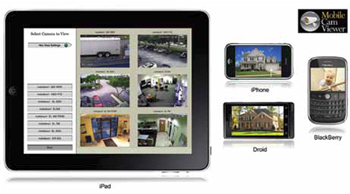How To Optimize Mobile Surveillance

Surveillance operations continue to grow and change as technology evolves. The transition from CCTV to IP cameras has been largely successful, and many businesses, educational facilities, law enforcement agencies, and other entities are now strategizing how to keep an eye on things while on the move.
The growing need to remotely monitor activity is increasingly important—allowing security personnel to respond quicker to events, and businesses to better protect financial interests and ease of operations and consumers for peace of mind and alarm verification. The good news is that this can be achieved at little to no additional cost based on the end-user’s current infrastructure.
Mobile surveillance leverages existing investments in cell phones, tablets, and video surveillance equipment, and has increased in popularity as camera prices decrease and mobile handheld capabilities improve. Free apps with basic service are available for download at app stores, and premium services are achieved through incremental costs.
Set up is simple, requiring only a few clicks to connect the app to IP/web cameras, DVRs, NVRs, and video servers—meaning that users can see live video streams within minutes. The best applications enhance customer ease of use by allowing remote viewing of video feeds without the need to open ports—a security risk—or otherwise modify and update firewall settings.
Set Up: Android or iOS
Mobile surveillance is a consumer-oriented product at its core. Even in the business and public safety worlds, most users have a standard knowledge and skill set. Therefore, set up must be simple.
The majority of mobile surveillance users today use Android or iOS devices to access their security systems. The configuration process for both device families is similar in the mobiDEOS universe, so we’ll focus on the iPhone for the purpose of this article.
A daily selection of features, industry news, and analysis for tech managers. Sign up below.
A typical user-friendly mobile surveillance application requires only a few clicks to connect the app to IP/web cameras, DVRs, NVRs and video servers—meaning that users can see live video streams within minutes. An iPhone user will typically start with a home page featuring a menu or icons that identify various options, from viewing cameras and editing setting to bringing new devices onto the network.

The best services will allow users to continually add new devices as security systems expand, whether or across single sites or to multiple locations.Users will first need to establish a server connection—some companies will offer several options based on the network requirements. A large banking business requiring maximum protection might require connection to a highly secure enterprise server, whereas a residential user can safely establish a secure, fault-tolerant public connection with a static IP address.
Users then simply need to walk through the steps of bringing devices onto the network. As an example, MobileCamViewer offers separate “Set Up Camera” and Set Up DVR/NVR” tabs, with subsequent menus to select camera models, and add identifying device names, static IP addresses, and port numbers. Preview windows with live connections will then confirm whether devices have been added and are viewable.
The best services will allow users to continually add new devices as security systems expand, whether or across single sites or to multiple locations.
Sri Palasamudram is CEO of mobiDEOS, Inc., manufacturer of the MobileCamViewer.
info
mobiDEOS
mobilecamviewer.com
